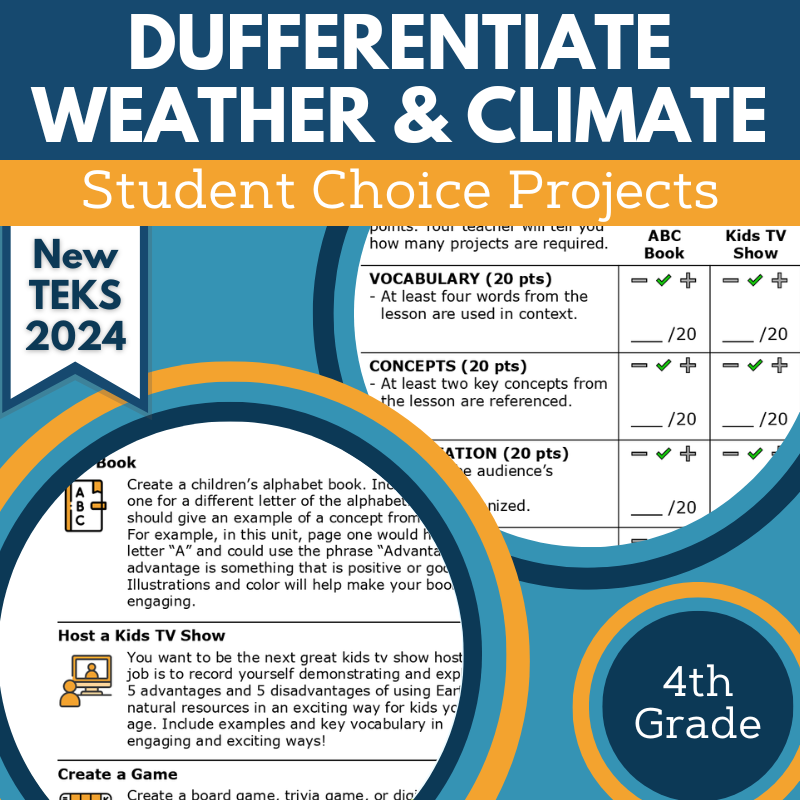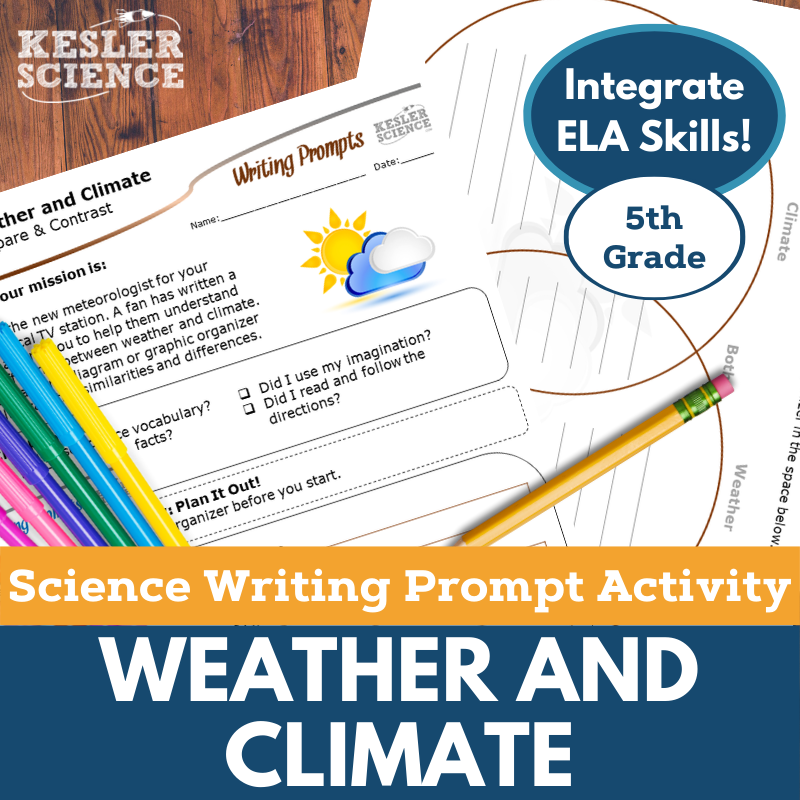Differentiate Weather & Climate Activities for 4th Grade Science
This engaging Earth science lesson helps 4th-grade students distinguish between weather and climate, aligning with the 2021 TEKS 4.10C standard. The resources below will give students a comprehensive understanding of weather and climate. All of the following materials are also included in the Kesler Science Membership.
The Kesler Science Differentiate Weather & Climate 5E Lesson is a comprehensive Earth science unit designed for 4th grade, focusing on distinguishing between weather and climate. Aligned with the 2021 TEKS 4.10C standard, this flexible, low-prep resource includes editable presentations, worksheets, choice projects, and assessments, supporting differentiated, student-led learning.
Following the 5E Model—Engage, Explore, Explain, Elaborate, and Evaluate—this lesson offers engaging discussion prompts, a hands-on station lab with nine multimodal stations, and activities like card sorts, drawing, and open-ended questions to help students explore climate factors and weather patterns. Editable PowerPoints, interactive notebooks, and note-taking templates in both English and Spanish support diverse learning needs. Students extend their understanding through choice projects and are assessed using STAAR 2.0-aligned questions, available in standard and modified formats. This versatile lesson is suitable for in-class or virtual learning environments.
The Kesler Science Differentiate Weather & Climate 5E Lesson is a comprehensive Earth science unit designed for 4th grade, focusing on distinguishing between weather and climate. Aligned with the 2021 TEKS 4.10C standard, this flexible, low-prep resource includes editable presentations, worksheets, choice projects, and assessments, supporting differentiated, student-led learning.
Following the 5E Model—Engage, Explore, Explain, Elaborate, and Evaluate—this lesson offers engaging discussion prompts, a hands-on station lab with nine multimodal stations, and activities like card sorts, drawing, and open-ended questions to help students explore climate factors and weather patterns. Editable PowerPoints, interactive notebooks, and note-taking templates in both English and Spanish support diverse learning needs. Students extend their understanding through choice projects and are assessed using STAAR 2.0-aligned questions, available in standard and modified formats. This versatile lesson is suitable for in-class or virtual learning environments.
Engage your 4th-grade students with this student-led station lab aligned with the 2021 TEKS 4.10C standard. This Earth science lesson helps students explore the differences between weather and climate while discovering the energy sources that drive these patterns. Designed for both in-class and virtual learning, the lab fosters independent exploration and critical thinking.
The resource features nine interactive stations with differentiated activities that allow students to direct their own learning. These stations include reading passages, videos, research tasks, and hands-on activities. Students connect concepts through application, sketch diagrams, organize information, and respond to prompts to demonstrate their understanding. A bonus challenge station offers extension activities for early finishers and advanced learners.
This low-prep, high-engagement resource supports multimodal learning and promotes active participation, making it an effective tool for teaching climate and weather concepts.
Engage your 4th-grade students with this student-led station lab aligned with the 2021 TEKS 4.10C standard. This Earth science lesson helps students explore the differences between weather and climate while discovering the energy sources that drive these patterns. Designed for both in-class and virtual learning, the lab fosters independent exploration and critical thinking.
The resource features nine interactive stations with differentiated activities that allow students to direct their own learning. These stations include reading passages, videos, research tasks, and hands-on activities. Students connect concepts through application, sketch diagrams, organize information, and respond to prompts to demonstrate their understanding. A bonus challenge station offers extension activities for early finishers and advanced learners.
This low-prep, high-engagement resource supports multimodal learning and promotes active participation, making it an effective tool for teaching climate and weather concepts.
The Climate and Weather Student Choice Projects align with the 2021 TEKS Earth and Weather standard 4.10C, allowing 4th-grade students to select a project that matches their preferred output style. A project page outlines six student-led options and a “design your own” project, with an editable rubric available for teacher, peer, or self-assessment. This resource is also part of the Differentiate Weather & Climate Complete Lesson for TEKS 4.10C.
These flexible, multimodal projects offer creative ways for students to demonstrate their understanding. Two versions of the project page support differentiation: a modified version provides targeted options for students needing remediation, while advanced learners can take on multiple projects using the same rubric. Teachers can adjust the rubric to fit grading needs.
The resource includes nine project options, a teacher directions page for guidance, and editable rubric pages assessing vocabulary, concepts, presentation, clarity, and accuracy. Projects are designed for completion with standard classroom supplies like paper, markers, and scissors, with many options available for digital submission.
The Climate and Weather Student Choice Projects align with the 2021 TEKS Earth and Weather standard 4.10C, allowing 4th-grade students to select a project that matches their preferred output style. A project page outlines six student-led options and a “design your own” project, with an editable rubric available for teacher, peer, or self-assessment. This resource is also part of the Differentiate Weather & Climate Complete Lesson for TEKS 4.10C.
These flexible, multimodal projects offer creative ways for students to demonstrate their understanding. Two versions of the project page support differentiation: a modified version provides targeted options for students needing remediation, while advanced learners can take on multiple projects using the same rubric. Teachers can adjust the rubric to fit grading needs.
The resource includes nine project options, a teacher directions page for guidance, and editable rubric pages assessing vocabulary, concepts, presentation, clarity, and accuracy. Projects are designed for completion with standard classroom supplies like paper, markers, and scissors, with many options available for digital submission.
The Weather and Climate Science and ELA Integrated Writing Activity engages 5th-grade students in comparing and contrasting weather and climate, reinforcing their understanding through creative, student-centered exercises. Designed to enhance science reasoning and writing skills, this low-prep activity is ideal for both in-person and virtual learning.
Aligned with TEKS and NGSS standards, the resource includes teacher directions with answer guides, project ideas, and rubrics. It offers projection-friendly prompts, full-sized and half-sheet handouts for interactive notebooks, and a digital PowerPoint version compatible with Google Slides for remote learners.
This versatile activity works well as a cross-curricular project, pre-test assessment, student choice assignment, enrichment for early finishers, extra credit, make-up work, TELPAS sample, or differentiation tool. It also makes an excellent display for bulletin boards or student anthologies. This prompt is intended for students with prior knowledge of the topic or access to research materials.
The Weather and Climate Science and ELA Integrated Writing Activity engages 5th-grade students in comparing and contrasting weather and climate, reinforcing their understanding through creative, student-centered exercises. Designed to enhance science reasoning and writing skills, this low-prep activity is ideal for both in-person and virtual learning.
Aligned with TEKS and NGSS standards, the resource includes teacher directions with answer guides, project ideas, and rubrics. It offers projection-friendly prompts, full-sized and half-sheet handouts for interactive notebooks, and a digital PowerPoint version compatible with Google Slides for remote learners.
This versatile activity works well as a cross-curricular project, pre-test assessment, student choice assignment, enrichment for early finishers, extra credit, make-up work, TELPAS sample, or differentiation tool. It also makes an excellent display for bulletin boards or student anthologies. This prompt is intended for students with prior knowledge of the topic or access to research materials.
The WIKI Tickets© formative assessments offer a fun and engaging way to check 3rd–5th grade students’ understanding of Earth and Space Science. This set includes 33 assessments, each available in five formats: a full-screen projection version, three printable handouts (full, split, and quarter-page sizes), and an interactive digital version compatible with PowerPoint and Google Slides.
Aligned with NGSS and TEKS standards for upper elementary science, each standard is covered by at least one ticket, with some topics featuring multiple assessments. A table of contents is also included to show standard alignment. These versatile assessments can be used in both classroom and virtual learning environments.
Topics include air temperature, wind direction, precipitation, Earth’s rotation, natural resources, weather patterns, soil properties, the water cycle, and more. WIKI Tickets© can serve as exit tickets, bellringers, or quick checks for understanding. They can be projected for whole-class participation, printed for individual use, or assigned digitally in 1:1 or remote learning settings.
The WIKI Tickets© formative assessments offer a fun and engaging way to check 3rd–5th grade students’ understanding of Earth and Space Science. This set includes 33 assessments, each available in five formats: a full-screen projection version, three printable handouts (full, split, and quarter-page sizes), and an interactive digital version compatible with PowerPoint and Google Slides.
Aligned with NGSS and TEKS standards for upper elementary science, each standard is covered by at least one ticket, with some topics featuring multiple assessments. A table of contents is also included to show standard alignment. These versatile assessments can be used in both classroom and virtual learning environments.
Topics include air temperature, wind direction, precipitation, Earth’s rotation, natural resources, weather patterns, soil properties, the water cycle, and more. WIKI Tickets© can serve as exit tickets, bellringers, or quick checks for understanding. They can be projected for whole-class participation, printed for individual use, or assigned digitally in 1:1 or remote learning settings.
Year-Round Resources
These year-round activities will increase your students' understanding of many middle school science topics. All of these activities are also included in the Kesler Science Membership.
Visual Data & Graphing
You're not alone if your students struggle with understanding graphs, charts, and tables. It's a skill that takes an enormous amount of practice. This resource will help students build a strong foundation in analyzing data and creating their own data visualizations.
Bell Ringers and Warm-Ups
These middle school science bell ringers are an excellent way to engage your students as soon as they walk into your classroom. This comprehensive FULL YEAR resource includes everything you need to start off each science class with an interesting warm-up activity.
Review Board Games
Each game board has been carefully designed to keep students engaged. There are 10 different action spaces on each board and dozens of question cards. All of the actions are related to science concepts and keep the students motivated throughout the game.
Each game is ready to play. Simply print out the board and the cards and let the students enjoy reviewing nine different units.
Essential Questions and Standards
Below are the essential questions and standards associated with the lessons and activities included in the atoms unit. This topic is only one of more than 100 middle school science topics included in the Kesler Science Membership.
-
How is weather different from climate?
-
Where does the energy that drives weather and climate patterns come from?
-
TEKS Science - 4.10C Differentiate Weather & Climate
Kesler Science Membership
Imagine never having to search for another middle school science lesson again. The membership gives you access to ALL of the Kesler Science products in one place (Yes, including everything above).
Say goodbye to long hours of lesson prep.











